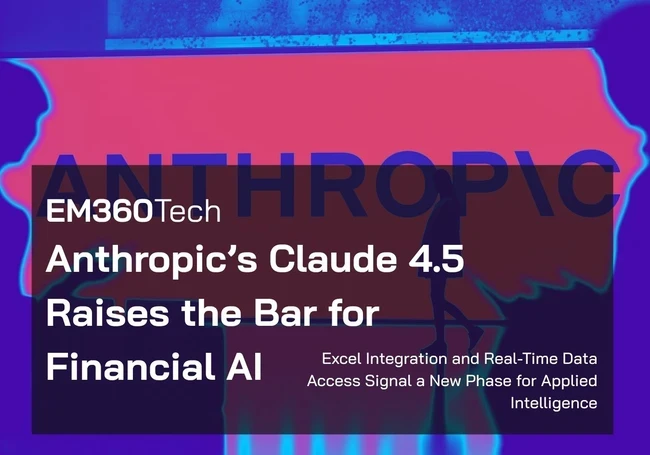
Financial services just crossed a line. Anthropic has pushed Claude 4.5 into the workbench that matters most to analysts and bankers: Microsoft Excel. Alongside a raft of licensed data connectors and pre-built Agent Skills, the company is staking a claim that financial AI is no longer a sidecar. It is part of the workflow.
Claude Sonnet 4.5 also leads the Finance Agent benchmark with 55.3 per cent accuracy, a signal that tool-using agents are maturing from demos to dependable help. The question for leaders is no longer whether to try AI. It is how to operationalise it with speed, control and auditability.
Why Claude 4.5 Marks A Benchmark Moment For Financial AI
The shift is not just another model release. Anthropic is embedding governed AI into the daily instruments of finance rather than asking teams to tab out to a chatbot. Excel is where modelling, sensitivity testing and reconciliation live.
Bringing an agent with cell-level awareness and change tracking into that space changes the tempo of work and the expectation of what “good” looks like.
For context, the Finance Agent benchmark evaluates whether an AI agent can complete tasks a junior financial analyst would handle, from simple retrieval to market research and projections.
Claude Sonnet 4.5 currently tops that leaderboard at 55.3 per cent, with the maintainers noting that many models still struggle with tool use and information retrieval. That gap matters. If an agent can reason but cannot reliably fetch, join and reference the right data, it will not earn trust in regulated environments.
The broader AI race has obsessed over model scale and headline scores. This moment is about domain precision. In finance, credibility beats creativity. The benchmark is useful not as a trophy, but as evidence that tool-use reliability is rising toward the bar that enterprise teams require.
Inside The Spreadsheet — Claude For Excel And Transparent Automation
If the benchmark proved Claude’s intelligence, the Excel integration proves its utility. Anthropic has taken the next logical step: putting its agent inside the environment where financial work actually happens. This isn’t about replacing analysts, but removing the friction between reasoning and doing — turning AI from an external tool into a built-in collaborator.
The productivity breakthrough
Claude for Excel runs as a sidebar that can read, analyse, modify and even create workbooks. The agent explains its actions, links directly to referenced cells and preserves formula dependencies.
That means analysts can ask for help restructuring a model, debugging a broken formula chain or rapidly populating a template with new assumptions without losing the architecture they trust. Early access is a beta research preview for Max, Enterprise and Teams customers, with a waitlist and an initial cohort of one thousand users to shape the rollout.
For finance teams, the tangible wins are straightforward. Less manual spreadsheet surgery. Fewer formula mistakes. Faster iteration when scenarios change during earnings, diligence or committee preparation. Crucially, the work stays in the same file type that teams, approvers and auditors already use.
Governance and auditability built in
Trust is the gatekeeper. Anthropic emphasises transparent change logs and cell-level traceability so reviewers can see what the agent touched and why. That visibility is the minimum viable requirement for environments aligned to SOX or Basel expectations, where teams need provenance, entitlements and a clean audit trail.
A capable agent that cannot show its work will stall in compliance review. Claude’s design choice here is pragmatic. It reduces the distance between experimentation and approval.
Live Data Pipelines — The Real Competitive Advantage
The other pillar is data. Anthropic is expanding connectors that give Claude immediate access to licensed sources, including:
- LSEG for live market data,
- Moody’s for credit research and company intelligence,
- Aiera for real-time earnings calls with a Third Bridge feed,
- Chronograph for private-equity portfolio analytics,
- Egnyte for governed search across internal data rooms, and
- MT Newswires for market coverage.
This is not generic web scraping. It is curated access with entitlements, usage controls and contractual guardrails.
The LSEG collaboration is particularly telling. It places trusted market data and analytics into the agent layer and sits alongside LSEG’s ongoing Microsoft alliance, signalling an ecosystem where the data backbone can power multiple agent platforms. Markets noticed.
Reporting tied the announcement to a lift in LSEG’s share price, and industry press framed the move as part of a larger strategy to feed AI agents with licensed, governed data at scale. The executive takeaway is simple. The next frontier of financial AI is not creativity. It is credibility.
The winners will combine strong reasoning with verified sources, clear entitlements and auditable flows from request to result.
Agent Skills And The Rise Of Specialist AI Colleagues
Anthropic has started packaging repeatable finance tasks into Agent Skills. These are modular folders containing instructions, scripts and resources that Claude can use across its apps and API.
The initial set covers comparable company analysis with valuation multiples and operating metrics, discounted cash flow models with WACC and sensitivity tables, earnings analyses that extract key metrics and guidance changes, due-diligence data packs, company teasers and profiles, and initiating coverage reports.
The effect is to shift the agent from a chatty generalist into a domain-literate colleague. Teams do not have to construct every workflow from scratch. They can start from a validated pattern, adapt it to house style and control it within their governance framework.
That reduces onboarding friction for new analysts and shortens the path to a production-ready flow for data and risk teams.
What This Means For Financial Enterprises
Every leap in capability brings a new set of decisions. For financial institutions, the question isn’t whether Claude can perform — it’s how to deploy it responsibly. Anthropic’s design choices point to a version of AI adoption that favours transparency, traceability, and measured speed over hype.
A faster, safer path to AI adoption
Executives have been clear about their blockers: bias, explainability, controls and legal risk. Claude’s Excel presence, licensed-data connectors and transparent logs speak directly to those concerns. The practical applications cut across the value chain.
Front office teams can synthesise earnings calls, generate comps and build structured client-ready outputs with less rework. Middle office teams can accelerate underwriting or compliance checks with governed retrieval and repeatable checklists. Back office teams can modernise code and streamline legacy processes with the same transparency that auditors expect.
Strategic implications for tech and data leaders
Adoption decisions now turn on entitlement management, validation pipelines and coexistence with Microsoft 365. Where does retrieval happen. How are results cached, reviewed and versioned.
Which logs become part of the formal record. These are the questions that move pilots through gates. The north star is compliance confidence. Capability alone will not carry an initiative to scale in 2026.
Competitive Context — The New Stack For Financial Intelligence
Anthropic’s move lands in a field where Microsoft Copilot has home advantage in Excel, BloombergGPT owns a data moat in capital markets and OpenAI continues to expand enterprise features. Anthropic’s bet is that cross-vendor interoperability, licensed connectors and transparent reasoning will differentiate in regulated environments.
LSEG’s approach shows how data providers can feed multiple ecosystems, including Microsoft’s agent platforms, using standards such as the Model Context Protocol to reduce integration friction. The data layer becomes both collaboration and competition at once. Advantage now lives where models meet markets, not where models stand alone.
Executive Takeaways — How Leaders Should Respond
For enterprise leaders, the implications are clear. The advantage now lies with those who move deliberately — building AI capabilities that are precise, governed, and aligned with business outcomes. These takeaways capture where that focus should land next.
- Prioritise domain-specific AI. General copilots struggle with audit depth. Choose agents that are comfortable inside your core tools and processes.
- Evaluate licensed-data integrations. Governance beats novelty. Verify entitlements, lineage and provider terms before you scale.
- Invest in trust architecture. Make audit logs, version control and validation pipelines standard practice rather than project extras.
- Treat AI as infrastructure. Benchmarks are useful, but reliability across tool chains is the real parity test. Build for resilience, not just peak scores.
Final Thoughts: Intelligence Only Matters When It’s Trusted
This update is a line in the sand. Financial AI has moved from promise to performance, and trust has become the currency that decides which deployments endure. The centre of gravity is shifting from isolated experiments to embedded, auditable workflows where models justify every step and data access is governed, not guessed.
The signal to watch is not the size of the model, but the fluency of the workflow and the integrity of the evidence behind it. The institutions that win the next decade will not be those that deploy AI first, but those that govern it best.
As accountable intelligence becomes the standard, EM360Tech tracks how leaders turn that standard into practice, from AI strategy to infrastructure that can carry it.


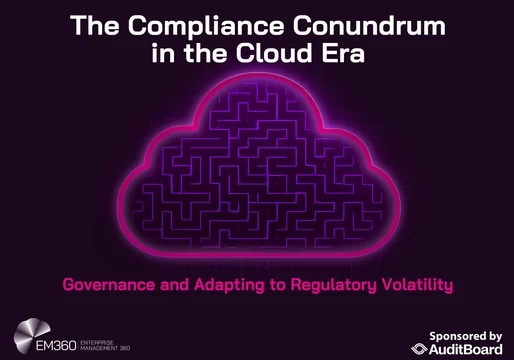



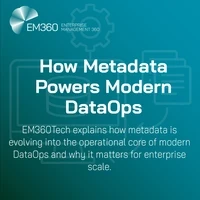

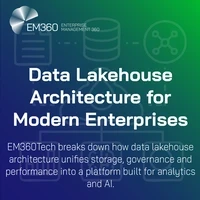




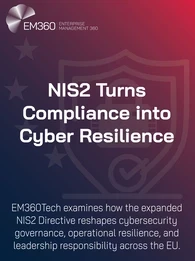
Comments ( 0 )